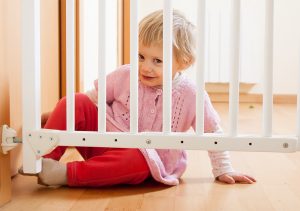 The most adorable pictures, sometimes, are those of a curious toddler in the most unimaginable places. Parents do not always have eyes in the back of their head, and so you need to take precautions once a baby or toddler learns how to crawl and walk around the house.
The most adorable pictures, sometimes, are those of a curious toddler in the most unimaginable places. Parents do not always have eyes in the back of their head, and so you need to take precautions once a baby or toddler learns how to crawl and walk around the house.
Whether you have a bundle of joy on the way or you already have one going up and down the steps of your home, here are some inexpensive tips for babyproofing the home for safety.
The thing to keep in mind when babyproofing is that babies will find any nook and cranny to get in or through. Expect the unexpected. An open plan layout might allow you to go along with your duties as you keep an eye on the child, but there are areas that need to be covered. Also, a proper smoke alarm system, a fire extinguisher, and emergency contacts are a MUST in every household.
The Living/Dining Room
Hazards here include the sharp corners of furniture like the coffee and dining tables and book shelves that can topple over when grabbed onto. Use padded corner guards on all the sharp edges of the furniture, and either secure to the wall or consider moving all the loose furniture that can easily tip over on the baby. Use electric tape to secure any loose laying electrical cords, and always tie and tuck the cords on curtain blinds. Secure all windows and doors with baby proof locks. The stairway should be secured with a safety gate that has a ringer and safety latch.
The Kitchen
This area poses numerous dangers to a child. From the poisonous chemicals to the stove top, appliances and other equipment. All cords must be hidden and out of the way. Kitchen appliances must be turned off and unplugged at all times after use. Safety latches should be used on all cupboard handles a baby can reach, latch on or pull out — unless it’s a “baby-approved” cabinet filled with plastic cups and lightweight pots and pans to keep them busy. All detergent should be stored in a locked cabinet, away from the kitchen, if possible. Also use edge protectors on any sharp corners in the kitchen.
The Bathroom
There are lots of easy safety measures to consider here, such as non-slip mats, safety latches on medicine cabinets and the toilet, etc. However, if possible, the bathroom door should be kept shut at all times and safety latches installed in order to prevent accidental drowning.
Outdoors
If you have a pool, have a safety gate latch in place and the pool cover secured. Avoid accidents and choking hazards by constantly supervising and checking your child’s play area and toys, and be quick to removing stones or anything small that a child can put in their mouth and swallow.
